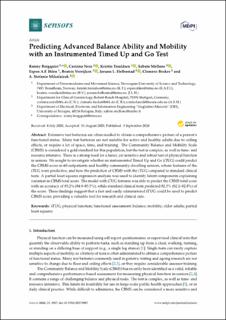| dc.contributor.author | Bergquist, Ronny | |
| dc.contributor.author | Nerz, Corinna | |
| dc.contributor.author | Taraldsen, Kristin | |
| dc.contributor.author | Mellone, Sabato | |
| dc.contributor.author | Ihlen, Espen Alexander F. | |
| dc.contributor.author | Vereijken, Beatrix | |
| dc.contributor.author | Helbostad, Jorunn L. | |
| dc.contributor.author | Becker, Clemens | |
| dc.contributor.author | Mikolaizak, A. Stefanie | |
| dc.date.accessioned | 2020-09-08T06:29:25Z | |
| dc.date.available | 2020-09-08T06:29:25Z | |
| dc.date.created | 2020-09-07T11:39:14Z | |
| dc.date.issued | 2020 | |
| dc.identifier.issn | 1424-8220 | |
| dc.identifier.uri | https://hdl.handle.net/11250/2676754 | |
| dc.description.abstract | Extensive test batteries are often needed to obtain a comprehensive picture of a person’s functional status. Many test batteries are not suitable for active and healthy adults due to ceiling effects, or require a lot of space, time, and training. The Community Balance and Mobility Scale (CBMS) is considered a gold standard for this population, but the test is complex, as well as time- and resource intensive. There is a strong need for a faster, yet sensitive and robust test of physical function in seniors. We sought to investigate whether an instrumented Timed Up and Go (iTUG) could predict the CBMS score in 60 outpatients and healthy community-dwelling seniors, where features of the iTUG were predictive, and how the prediction of CBMS with the iTUG compared to standard clinical tests. A partial least squares regression analysis was used to identify latent components explaining variation in CBMS total score. The model with iTUG features was able to predict the CBMS total score with an accuracy of 85.2% (84.9–85.5%), while standard clinical tests predicted 82.5% (82.2–82.8%) of the score. These findings suggest that a fast and easily administered iTUG could be used to predict CBMS score, providing a valuable tool for research and clinical care. | en_US |
| dc.language.iso | eng | en_US |
| dc.publisher | MDPI | en_US |
| dc.rights | Navngivelse 4.0 Internasjonal | * |
| dc.rights.uri | http://creativecommons.org/licenses/by/4.0/deed.no | * |
| dc.title | Predicting Advanced Balance Ability and Mobility with an Instrumented Timed Up and Go Test | en_US |
| dc.type | Peer reviewed | en_US |
| dc.type | Journal article | en_US |
| dc.description.version | publishedVersion | en_US |
| dc.source.journal | Sensors | en_US |
| dc.identifier.doi | 10.3390/s20174987 | |
| dc.identifier.cristin | 1827709 | |
| dc.description.localcode | © 2020 by the authors. Licensee MDPI, Basel, Switzerland. This article is an open access article distributed under the terms and conditions of the Creative Commons Attribution (CC BY) license (http://creativecommons.org/licenses/by/4.0/). | en_US |
| cristin.ispublished | true | |
| cristin.fulltext | postprint | |
| cristin.qualitycode | 1 | |

